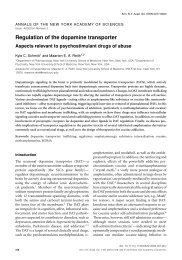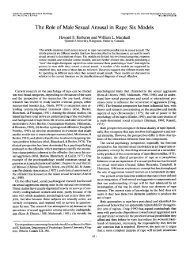How does stress increase risk of drug abuse - Addiction Research ...
How does stress increase risk of drug abuse - Addiction Research ...
How does stress increase risk of drug abuse - Addiction Research ...
You also want an ePaper? Increase the reach of your titles
YUMPU automatically turns print PDFs into web optimized ePapers that Google loves.
sponse to cocaine, alcohol, nicotine and opiates with<br />
chronic <strong>abuse</strong> has been reported (Eisenman et al. 1969;<br />
Delitala et al. 1983; Friedman et al. 1987; Mendelson et<br />
al. 1998). These findings suggest that active <strong>drug</strong> use,<br />
acute and protracted withdrawal and tolerance symptoms<br />
are associated with alterations in brain <strong>stress</strong> circuits.<br />
Neuroadaptations in the mesolimbic dopaminergic<br />
system as a result <strong>of</strong> chronic <strong>drug</strong> <strong>abuse</strong> have also been<br />
documented. Both <strong>stress</strong> and psychostimulants <strong>increase</strong><br />
dopaminergic transmission in the nucleus accumbens<br />
and other regions <strong>of</strong> the mesolimbic reward pathways<br />
(Thierry et al. 1976; Roberts et al. 1980; Taylor and<br />
Robbins 1984; Di Chiara and Imperato 1988; Dunn<br />
1988; Kalivas and Duffy 1989; Piazza and Le Moal<br />
1996). Reduced dopamine transmission in the nucleus<br />
accumbens during acute withdrawal from opiates, cocaine,<br />
alcohol, marijuana and nicotine has been reported<br />
(Acquas et al. 1991; Diana et al. 1993, 1998; Kuhar and<br />
Pilotte 1996; Hildebrand et al. 1998). On the other hand,<br />
“sensitization” or enhanced behavioral and neurochemical<br />
response to <strong>drug</strong>s and to <strong>stress</strong> has been noted subsequent<br />
to acute withdrawal in dependent animals. This<br />
process <strong>of</strong> sensitization has been associated with longterm<br />
changes in dopamine release and transduction in<br />
specific areas <strong>of</strong> the mesocorticolimbic dopamine system<br />
(Robinson and Berridge 1993, 2000; Nestler et al. 1993;<br />
White et al. 1995; Pierce and Kalivas 1997). An intriguing<br />
aspect <strong>of</strong> sensitization is that exposure to <strong>drug</strong>s and<br />
to <strong>stress</strong> in addicted animals produces a sensitized behavioral<br />
and pharmacological response to the <strong>drug</strong><br />
(Robinson and Berridge 1993; Kalivas et al. 1998). For<br />
example, augmentation <strong>of</strong> dopamine transmission in the<br />
nucleus accumbens and reduced dopamine release in the<br />
prefrontal cortex has been reported with cocaine and<br />
with <strong>stress</strong> exposure, in animals pretreated with daily cocaine<br />
(Sorg and Kalivas 1993; Hooks et al. 1994; Sorg et<br />
al. 1997). These long-term changes in brain reward pathways<br />
as a result <strong>of</strong> chronic <strong>drug</strong> <strong>abuse</strong> have been hypothesized<br />
to play a key role in craving, <strong>drug</strong>-seeking behavior<br />
and relapse (Robinson and Berridge 1993, 2000;<br />
Kalivas et al. 1998). The section below on <strong>drug</strong> craving<br />
will examine this aspect in greater detail.<br />
Brain imaging studies have reported short and longterm<br />
changes in the dopaminergic system in humans. Reduced<br />
glucose metabolism especially in frontal regions<br />
during both acute and protracted withdrawal (up to<br />
3–4 months) from cocaine has been observed (Volkow et<br />
al. 1990, 1991, 1992). Alcoholics and cocaine <strong>abuse</strong>rs<br />
show a significant reduction in dopamine D 2 receptors as<br />
compared to healthy controls, particularly in frontalstriatal<br />
regions (Volkow et al. 1993, 1996, 1997). Some<br />
evidence also suggests <strong>increase</strong>d density <strong>of</strong> dopamine<br />
transporter binding sites in the striatum with chronic cocaine<br />
<strong>abuse</strong> (Malison et al. 1998; Staley et al. 1994;<br />
Little et al. 1999), a finding that has been replicated<br />
in rhesus monkeys chronically exposed to cocaine<br />
(Letchworth et al. 2001). Thus, these data point to alterations<br />
in frontal and striatal regions <strong>of</strong> the dopaminergic<br />
pathways, that exist past acute withdrawal, and may be<br />
associated with cognitive, affective and behavioral<br />
symptoms during protracted withdrawal and relapse<br />
(Porrino and Lyons 2000; Volkow and Fowler 2000).<br />
Psychobiological changes during early abstinence<br />
from <strong>drug</strong>s<br />
349<br />
Increases in irritability, anxiety, emotional di<strong>stress</strong>, sleep<br />
problems, dysphoria, aggressive behaviors and <strong>drug</strong><br />
craving are common during early abstinence from alcohol,<br />
cocaine, opiates, nicotine and marijuana (1992;<br />
American Psychiatric Association 1994; Kouri et al.<br />
1999). Recent conceptualizations <strong>of</strong> <strong>drug</strong> dependence<br />
emphasize the establishment <strong>of</strong> a “negative affect” or<br />
psychologically di<strong>stress</strong>ed state during abstinence in addicts,<br />
potentially associated with neuroadaptive changes<br />
in brain <strong>stress</strong> and reward circuits (Koob and Le Moal<br />
1997; Kreek and Koob 1998; Volkow and Fowler 2000).<br />
Severity <strong>of</strong> the above abstinence symptoms are known to<br />
predict treatment outcome and relapse among smokers,<br />
cocaine addicts, heroin dependent individuals and alcoholics<br />
(McLellan et al. 1983; Carroll et al. 1993; Doherty<br />
et al. 1995; Tennant et al. 1991; Mulvaney et al. 1999).<br />
In general, findings indicate that the greater the dependence<br />
and abstinence severity, greater the susceptibility<br />
to relapse and poor treatment outcome. <strong>How</strong>ever, few<br />
studies have systematically examined frequency and severity<br />
<strong>of</strong> abstinence symptoms and specific neurobiological<br />
changes in the above-mentioned systems. Recent exceptions<br />
include Elman et al.’s (1999) findings showing<br />
a positive association between <strong>increase</strong>d ACTH and cortisol<br />
levels and depressive symptoms during cocaine<br />
crash in cocaine addicts, and Frederick et al.’s (1998)<br />
findings on the association between cortisol levels and<br />
nicotine withdrawal-related di<strong>stress</strong>.<br />
While some evidence suggests that alcoholics and<br />
opiate addicts report significantly greater <strong>stress</strong>ful life<br />
events than healthy controls (Kosten et al. 1983, 1986),<br />
few studies have examined how <strong>drug</strong> dependent individuals<br />
respond to <strong>stress</strong> and whether <strong>drug</strong> <strong>abuse</strong> results in<br />
an altered <strong>stress</strong> response. Studies with smokers indicate<br />
a blunted cortisol response in response to the <strong>stress</strong> <strong>of</strong><br />
public speaking and mental arithmetic as compared to<br />
non-smokers, but such blunting is not present in response<br />
to exercise or hCRF challenge (Kirschbaum et al.<br />
1993; Roy et al. 1994). Similarly, a blunted cortisol response<br />
to public speaking <strong>stress</strong> has also been reported<br />
in alcoholics and those addicted to both cocaine and alcohol,<br />
as compared to healthy controls (Errico et al.<br />
1993; Lovallo et al. 2000). Kirschbaum et al.’s findings<br />
indicating intact pituitary-adrenal response to exercise<br />
and hCRF challenge but not with psychological <strong>stress</strong><br />
suggests that supra-pituitary <strong>stress</strong> circuits may be responsible<br />
for the blunted <strong>stress</strong>-related cortisol changes.<br />
CRF-containing neurons from the basal forebrain and the<br />
amygdala are known to project into the para-ventricular<br />
nucleus (PVN) (Gallagher et al. 1987; Petrusz and<br />
Merchenthaler 1992) and amygdaloid lesions are known










